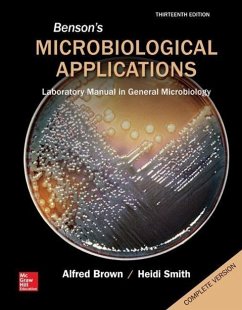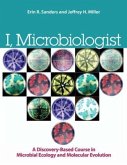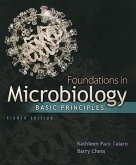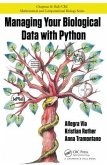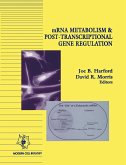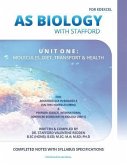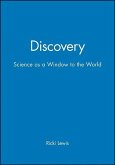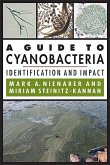- Broschiertes Buch
- Merkliste
- Auf die Merkliste
- Bewerten Bewerten
- Teilen
- Produkt teilen
- Produkterinnerung
- Produkterinnerung
NEW EDITION COMING OCTOBER 2016 Benson's Microbiological Applications has been the gold standard of microbiology laboratory manuals for over 30 years. The 77 self-contained, clearly-illustrated exercises, and four-color format with a wealth of added photographs makes this the ideal lab manual. Appropriate for either a majors or non-majors lab course, this manual assumes no prior organic chemistry course has been taken.
Andere Kunden interessierten sich auch für
![I, Microbiologist I, Microbiologist]() Erin Sanders-LorenzI, Microbiologist88,99 €
Erin Sanders-LorenzI, Microbiologist88,99 €![Foundations in Microbiology: Basic Principles Foundations in Microbiology: Basic Principles]() Kathleen P. TalaroFoundations in Microbiology: Basic Principles212,99 €
Kathleen P. TalaroFoundations in Microbiology: Basic Principles212,99 €![Managing Your Biological Data with Python Managing Your Biological Data with Python]() Allegra ViaManaging Your Biological Data with Python95,99 €
Allegra ViaManaging Your Biological Data with Python95,99 €![Mrna Metabolism & Post-Transcriptional Gene Regulation Mrna Metabolism & Post-Transcriptional Gene Regulation]() Mrna Metabolism & Post-Transcriptional Gene Regulation381,99 €
Mrna Metabolism & Post-Transcriptional Gene Regulation381,99 €![AS Biology with Stafford: Unit One: Molecules, Diet, Transport and Health AS Biology with Stafford: Unit One: Molecules, Diet, Transport and Health]() Stafford Valentine ReddenAS Biology with Stafford: Unit One: Molecules, Diet, Transport and Health29,99 €
Stafford Valentine ReddenAS Biology with Stafford: Unit One: Molecules, Diet, Transport and Health29,99 €![Discovery Discovery]() Ricki LewisDiscovery108,99 €
Ricki LewisDiscovery108,99 €![A Guide to Cyanobacteria A Guide to Cyanobacteria]() Mark A NienaberA Guide to Cyanobacteria23,99 €
Mark A NienaberA Guide to Cyanobacteria23,99 €-
-
-
NEW EDITION COMING OCTOBER 2016 Benson's Microbiological Applications has been the gold standard of microbiology laboratory manuals for over 30 years. The 77 self-contained, clearly-illustrated exercises, and four-color format with a wealth of added photographs makes this the ideal lab manual. Appropriate for either a majors or non-majors lab course, this manual assumes no prior organic chemistry course has been taken.
Hinweis: Dieser Artikel kann nur an eine deutsche Lieferadresse ausgeliefert werden.
Hinweis: Dieser Artikel kann nur an eine deutsche Lieferadresse ausgeliefert werden.
Produktdetails
- Produktdetails
- Verlag: McGraw Hill LLC
- Revised
- Seitenzahl: 576
- Altersempfehlung: ab 18 Jahre
- Erscheinungstermin: 3. Januar 2014
- Englisch
- Abmessung: 272mm x 213mm x 23mm
- Gewicht: 1157g
- ISBN-13: 9780077668020
- ISBN-10: 0077668022
- Artikelnr.: 40336254
- Herstellerkennzeichnung
- Libri GmbH
- Europaallee 1
- 36244 Bad Hersfeld
- gpsr@libri.de
- Verlag: McGraw Hill LLC
- Revised
- Seitenzahl: 576
- Altersempfehlung: ab 18 Jahre
- Erscheinungstermin: 3. Januar 2014
- Englisch
- Abmessung: 272mm x 213mm x 23mm
- Gewicht: 1157g
- ISBN-13: 9780077668020
- ISBN-10: 0077668022
- Artikelnr.: 40336254
- Herstellerkennzeichnung
- Libri GmbH
- Europaallee 1
- 36244 Bad Hersfeld
- gpsr@libri.de
Professor and Chair, Consultant Environmental Microbiology
Part 1 Microscopy
1 Brightfield Microscopy
2 Darkfield Microscopy
3 Phase-Contrast Microscopy
4 Fluorescence Microscopy
5 Microscopic Measurements
Part 2 Survey of Microorganisms
6 Microbiology of Pond Water - Protists, Algae, and Cyanobacteria
7 Ubiquity of Bacteria
8 The Fungi: Molds and Yeasts
Part 3 Manipulation of Microorganisms
9 Aseptic Technique
10 Pure Culture Techniques
Part 4 Staining and Observations of Microorganisms
11 Smear Preparation
12 Simple Staining
13 Negative Staining
14 Capsular Staining
15 Gram Staining
16 Spore Staining: Two Methods
17 Acid-Fast Staining: Kinyoun Method
18 Motility Determination
Part 5 Culture Methods
19 Culture Media Preparation
20 Preparation of Stock Cultures
21 Enumeration of Bacteria: The Standard Plate Count
22 Slide Culture: Fungi
Part 6 Bacterial Viruses
23 Determination of a Bacteriophage Titer
24 A One-Step Bacteriophage Growth Curve
25 Isolation of Phage from Flies
26 Phage Typing
Part 7 Environmental Influences and Control of Microbial Growth
27 Effects of Oxygen on Growth
28 Temperature: Effects on Growth
29 pH and Microbial Growth
30 Water Activity and Osmotic Pressure
31 Ultraviolet Light: Lethal Effects
32 The Effects of Lysozyme on Bacterial Cells
33 Evaluation of Alcohol: Its Effectiveness as an Antiseptic
34 Antimicrobic Sensitivity Testing: The Kirby-Bauer Method
35 Evaluation of Antiseptics: The Filter Paper Disk Method
36 Effectiveness of Hand Scrubbing
Part 8 Identification of Unknown Bacteria
37 Morphological Study of An Unknown Bacterium
38 Cultural Characteristics
39 Physiological Characteristics: Oxidation and Fermentation Stet Reactions
40 Physiological Characteristics: Hydrolytic and Degradative Stet Reactions
41 Physiological Characteristics: Multiple Test Media
42 Use of Bergey's Manual
Part 9 Miniaturized Multitest Systems
43 Enterobacteriaceae Identification: The API 20E System
44 Enterobacteriaceae Identification: The Enterotube II System
45 O/F Gram-Negative Rods Identification: The Oxi/Ferm Tube II System
46 Staphylococcus Identification: The API Staph System
Part 10 Diversity and Environmental Microbiology
47 Isolation of an Antibiotic Producer: The Streptomyces
48 Nitrogen Cycle: Ammonification
49 Symbiotic Nitrogen Fixation: Rhizobium
50 Free-Living Nitrogen Fixation: Azotobacter
51 Denitrification: Paracoccus denitrificans
52 The Winogradsky Column
53 Purple Nonsulfur Photosynthetic Bacteria
54 Sulfate Reducing Bacteria: Desulfovibrio
55 Bacterial Commensalism
56 Bacterial Synergism
57 Microbial Antagonism
Part 11 Applied Microbiology
58 Bacterial Food Counts
59 Bacteriological Examination of Water: Most Probable Number Determination
60 Bacteriological Examination of Water: The Membrane Filter Method
61 Reductase Test
62 Temperature: Lethal Effects
63 Microbial Spoilage of Canned Food
64 Microbiology of Alcohol Fermentation
Part 12 Bacterial Genetics and Biotechnology
65 Mutant Isolation by Replica Plating
66 Bacterial Transformation
67 Polymerase Chain Reaction for Amplifying DNA
68 Plasmid Isolation
Part 13 Medical Microbiology
69 The Staphylococci: Isolation and Identification
70 The Streptococci and Enterococci: Isolation and Identification
71 Gram-Negative Intestinal Pathogens
72 A Synthetic Epidemic
Part 14 Immunology and Serology
73 Slide Agglutination Test: Serological Typing
74 Slide Agglutination Test for S. aureus
75 Slide Agglutination Test for Streptococcus
76 The Heterophile Antibody Test
77 Blood Grouping
Appendices
1 Brightfield Microscopy
2 Darkfield Microscopy
3 Phase-Contrast Microscopy
4 Fluorescence Microscopy
5 Microscopic Measurements
Part 2 Survey of Microorganisms
6 Microbiology of Pond Water - Protists, Algae, and Cyanobacteria
7 Ubiquity of Bacteria
8 The Fungi: Molds and Yeasts
Part 3 Manipulation of Microorganisms
9 Aseptic Technique
10 Pure Culture Techniques
Part 4 Staining and Observations of Microorganisms
11 Smear Preparation
12 Simple Staining
13 Negative Staining
14 Capsular Staining
15 Gram Staining
16 Spore Staining: Two Methods
17 Acid-Fast Staining: Kinyoun Method
18 Motility Determination
Part 5 Culture Methods
19 Culture Media Preparation
20 Preparation of Stock Cultures
21 Enumeration of Bacteria: The Standard Plate Count
22 Slide Culture: Fungi
Part 6 Bacterial Viruses
23 Determination of a Bacteriophage Titer
24 A One-Step Bacteriophage Growth Curve
25 Isolation of Phage from Flies
26 Phage Typing
Part 7 Environmental Influences and Control of Microbial Growth
27 Effects of Oxygen on Growth
28 Temperature: Effects on Growth
29 pH and Microbial Growth
30 Water Activity and Osmotic Pressure
31 Ultraviolet Light: Lethal Effects
32 The Effects of Lysozyme on Bacterial Cells
33 Evaluation of Alcohol: Its Effectiveness as an Antiseptic
34 Antimicrobic Sensitivity Testing: The Kirby-Bauer Method
35 Evaluation of Antiseptics: The Filter Paper Disk Method
36 Effectiveness of Hand Scrubbing
Part 8 Identification of Unknown Bacteria
37 Morphological Study of An Unknown Bacterium
38 Cultural Characteristics
39 Physiological Characteristics: Oxidation and Fermentation Stet Reactions
40 Physiological Characteristics: Hydrolytic and Degradative Stet Reactions
41 Physiological Characteristics: Multiple Test Media
42 Use of Bergey's Manual
Part 9 Miniaturized Multitest Systems
43 Enterobacteriaceae Identification: The API 20E System
44 Enterobacteriaceae Identification: The Enterotube II System
45 O/F Gram-Negative Rods Identification: The Oxi/Ferm Tube II System
46 Staphylococcus Identification: The API Staph System
Part 10 Diversity and Environmental Microbiology
47 Isolation of an Antibiotic Producer: The Streptomyces
48 Nitrogen Cycle: Ammonification
49 Symbiotic Nitrogen Fixation: Rhizobium
50 Free-Living Nitrogen Fixation: Azotobacter
51 Denitrification: Paracoccus denitrificans
52 The Winogradsky Column
53 Purple Nonsulfur Photosynthetic Bacteria
54 Sulfate Reducing Bacteria: Desulfovibrio
55 Bacterial Commensalism
56 Bacterial Synergism
57 Microbial Antagonism
Part 11 Applied Microbiology
58 Bacterial Food Counts
59 Bacteriological Examination of Water: Most Probable Number Determination
60 Bacteriological Examination of Water: The Membrane Filter Method
61 Reductase Test
62 Temperature: Lethal Effects
63 Microbial Spoilage of Canned Food
64 Microbiology of Alcohol Fermentation
Part 12 Bacterial Genetics and Biotechnology
65 Mutant Isolation by Replica Plating
66 Bacterial Transformation
67 Polymerase Chain Reaction for Amplifying DNA
68 Plasmid Isolation
Part 13 Medical Microbiology
69 The Staphylococci: Isolation and Identification
70 The Streptococci and Enterococci: Isolation and Identification
71 Gram-Negative Intestinal Pathogens
72 A Synthetic Epidemic
Part 14 Immunology and Serology
73 Slide Agglutination Test: Serological Typing
74 Slide Agglutination Test for S. aureus
75 Slide Agglutination Test for Streptococcus
76 The Heterophile Antibody Test
77 Blood Grouping
Appendices
Part 1 Microscopy
1 Brightfield Microscopy
2 Darkfield Microscopy
3 Phase-Contrast Microscopy
4 Fluorescence Microscopy
5 Microscopic Measurements
Part 2 Survey of Microorganisms
6 Microbiology of Pond Water - Protists, Algae, and Cyanobacteria
7 Ubiquity of Bacteria
8 The Fungi: Molds and Yeasts
Part 3 Manipulation of Microorganisms
9 Aseptic Technique
10 Pure Culture Techniques
Part 4 Staining and Observations of Microorganisms
11 Smear Preparation
12 Simple Staining
13 Negative Staining
14 Capsular Staining
15 Gram Staining
16 Spore Staining: Two Methods
17 Acid-Fast Staining: Kinyoun Method
18 Motility Determination
Part 5 Culture Methods
19 Culture Media Preparation
20 Preparation of Stock Cultures
21 Enumeration of Bacteria: The Standard Plate Count
22 Slide Culture: Fungi
Part 6 Bacterial Viruses
23 Determination of a Bacteriophage Titer
24 A One-Step Bacteriophage Growth Curve
25 Isolation of Phage from Flies
26 Phage Typing
Part 7 Environmental Influences and Control of Microbial Growth
27 Effects of Oxygen on Growth
28 Temperature: Effects on Growth
29 pH and Microbial Growth
30 Water Activity and Osmotic Pressure
31 Ultraviolet Light: Lethal Effects
32 The Effects of Lysozyme on Bacterial Cells
33 Evaluation of Alcohol: Its Effectiveness as an Antiseptic
34 Antimicrobic Sensitivity Testing: The Kirby-Bauer Method
35 Evaluation of Antiseptics: The Filter Paper Disk Method
36 Effectiveness of Hand Scrubbing
Part 8 Identification of Unknown Bacteria
37 Morphological Study of An Unknown Bacterium
38 Cultural Characteristics
39 Physiological Characteristics: Oxidation and Fermentation Stet Reactions
40 Physiological Characteristics: Hydrolytic and Degradative Stet Reactions
41 Physiological Characteristics: Multiple Test Media
42 Use of Bergey's Manual
Part 9 Miniaturized Multitest Systems
43 Enterobacteriaceae Identification: The API 20E System
44 Enterobacteriaceae Identification: The Enterotube II System
45 O/F Gram-Negative Rods Identification: The Oxi/Ferm Tube II System
46 Staphylococcus Identification: The API Staph System
Part 10 Diversity and Environmental Microbiology
47 Isolation of an Antibiotic Producer: The Streptomyces
48 Nitrogen Cycle: Ammonification
49 Symbiotic Nitrogen Fixation: Rhizobium
50 Free-Living Nitrogen Fixation: Azotobacter
51 Denitrification: Paracoccus denitrificans
52 The Winogradsky Column
53 Purple Nonsulfur Photosynthetic Bacteria
54 Sulfate Reducing Bacteria: Desulfovibrio
55 Bacterial Commensalism
56 Bacterial Synergism
57 Microbial Antagonism
Part 11 Applied Microbiology
58 Bacterial Food Counts
59 Bacteriological Examination of Water: Most Probable Number Determination
60 Bacteriological Examination of Water: The Membrane Filter Method
61 Reductase Test
62 Temperature: Lethal Effects
63 Microbial Spoilage of Canned Food
64 Microbiology of Alcohol Fermentation
Part 12 Bacterial Genetics and Biotechnology
65 Mutant Isolation by Replica Plating
66 Bacterial Transformation
67 Polymerase Chain Reaction for Amplifying DNA
68 Plasmid Isolation
Part 13 Medical Microbiology
69 The Staphylococci: Isolation and Identification
70 The Streptococci and Enterococci: Isolation and Identification
71 Gram-Negative Intestinal Pathogens
72 A Synthetic Epidemic
Part 14 Immunology and Serology
73 Slide Agglutination Test: Serological Typing
74 Slide Agglutination Test for S. aureus
75 Slide Agglutination Test for Streptococcus
76 The Heterophile Antibody Test
77 Blood Grouping
Appendices
1 Brightfield Microscopy
2 Darkfield Microscopy
3 Phase-Contrast Microscopy
4 Fluorescence Microscopy
5 Microscopic Measurements
Part 2 Survey of Microorganisms
6 Microbiology of Pond Water - Protists, Algae, and Cyanobacteria
7 Ubiquity of Bacteria
8 The Fungi: Molds and Yeasts
Part 3 Manipulation of Microorganisms
9 Aseptic Technique
10 Pure Culture Techniques
Part 4 Staining and Observations of Microorganisms
11 Smear Preparation
12 Simple Staining
13 Negative Staining
14 Capsular Staining
15 Gram Staining
16 Spore Staining: Two Methods
17 Acid-Fast Staining: Kinyoun Method
18 Motility Determination
Part 5 Culture Methods
19 Culture Media Preparation
20 Preparation of Stock Cultures
21 Enumeration of Bacteria: The Standard Plate Count
22 Slide Culture: Fungi
Part 6 Bacterial Viruses
23 Determination of a Bacteriophage Titer
24 A One-Step Bacteriophage Growth Curve
25 Isolation of Phage from Flies
26 Phage Typing
Part 7 Environmental Influences and Control of Microbial Growth
27 Effects of Oxygen on Growth
28 Temperature: Effects on Growth
29 pH and Microbial Growth
30 Water Activity and Osmotic Pressure
31 Ultraviolet Light: Lethal Effects
32 The Effects of Lysozyme on Bacterial Cells
33 Evaluation of Alcohol: Its Effectiveness as an Antiseptic
34 Antimicrobic Sensitivity Testing: The Kirby-Bauer Method
35 Evaluation of Antiseptics: The Filter Paper Disk Method
36 Effectiveness of Hand Scrubbing
Part 8 Identification of Unknown Bacteria
37 Morphological Study of An Unknown Bacterium
38 Cultural Characteristics
39 Physiological Characteristics: Oxidation and Fermentation Stet Reactions
40 Physiological Characteristics: Hydrolytic and Degradative Stet Reactions
41 Physiological Characteristics: Multiple Test Media
42 Use of Bergey's Manual
Part 9 Miniaturized Multitest Systems
43 Enterobacteriaceae Identification: The API 20E System
44 Enterobacteriaceae Identification: The Enterotube II System
45 O/F Gram-Negative Rods Identification: The Oxi/Ferm Tube II System
46 Staphylococcus Identification: The API Staph System
Part 10 Diversity and Environmental Microbiology
47 Isolation of an Antibiotic Producer: The Streptomyces
48 Nitrogen Cycle: Ammonification
49 Symbiotic Nitrogen Fixation: Rhizobium
50 Free-Living Nitrogen Fixation: Azotobacter
51 Denitrification: Paracoccus denitrificans
52 The Winogradsky Column
53 Purple Nonsulfur Photosynthetic Bacteria
54 Sulfate Reducing Bacteria: Desulfovibrio
55 Bacterial Commensalism
56 Bacterial Synergism
57 Microbial Antagonism
Part 11 Applied Microbiology
58 Bacterial Food Counts
59 Bacteriological Examination of Water: Most Probable Number Determination
60 Bacteriological Examination of Water: The Membrane Filter Method
61 Reductase Test
62 Temperature: Lethal Effects
63 Microbial Spoilage of Canned Food
64 Microbiology of Alcohol Fermentation
Part 12 Bacterial Genetics and Biotechnology
65 Mutant Isolation by Replica Plating
66 Bacterial Transformation
67 Polymerase Chain Reaction for Amplifying DNA
68 Plasmid Isolation
Part 13 Medical Microbiology
69 The Staphylococci: Isolation and Identification
70 The Streptococci and Enterococci: Isolation and Identification
71 Gram-Negative Intestinal Pathogens
72 A Synthetic Epidemic
Part 14 Immunology and Serology
73 Slide Agglutination Test: Serological Typing
74 Slide Agglutination Test for S. aureus
75 Slide Agglutination Test for Streptococcus
76 The Heterophile Antibody Test
77 Blood Grouping
Appendices

